I have noticed there has been a lot of confusion with the engines commonly used with swapping in and out of the MM. There are MANY to chose from, and there are decent write-ups for each. However, the combo engines, or “hybrids/variants” are the ones people seem to struggle with.
There is very little information out there regarding RWD Mitsubishi engines, and what info is available is either outdated, missing info, flat out wrong, or perceived as “the only way” to do the job. This article is intended to clear it up and answer some of those questions.
As my build nears swap time, I have been sharing many pics and some info. Just about everyone has been sending messages and info inquiries my way as to “how” I am dropping an Evo variant into my truck. I don’t mind answering questions, but the inquiries are becoming too frequent for me to keep writing the same responses over and over again.
To kick this off - Yes. I am swapping what people would label an “Evo engine” into my truck. It is absolutely NOT the very popular DSM engine. To be more mechanically correct - my engine is an Evo “Variant” meaning the casting and orientation of the parts I am using is similar to the Evo. Virtually everything from the Evo fits the variant I am building. As such, swapping the actual Evo engine into the truck is completely possible. My variant, other variants, the engines themselves (without variation), and other common hybrid type swaps will be explained here.
Instructions
Yes, this is a very long read. I know. You should start reading from the beginning and finish at the end. Read all of it, and do not skip around, even if you think you know all about it.
The reason why is the order in which I explain everything. If you skip over sections, you will miss the info related to the previous section and post section. Its all written in a particular order to make the most sense and give the most understanding.
The Lingo
Simply put, there are 2 types of casting: DSM & Evo
There are also 3 main types of blocks to discuss here:
- Wide block
- Narrow Block
- Front Wheel Drive (FWD) or Rear Wheel Drive (RWD)
FWD/RWD is technically 2 types, but wide blocks, as they pertain to this article, are only RWD.
Blocks
DSM blocks are very similar to the Evo styles in that they have the same general dimensions, many bolt holes line up the same, and they are both part of the 4G6X family. There is one huge difference between the two - the deck casting.
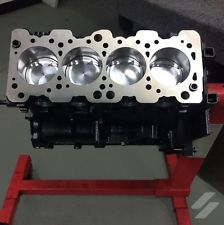
Evo blocks are also very similar to the DSM styles in the same way as above. However, there are 2 differences. The first one is obviously the deck casting.
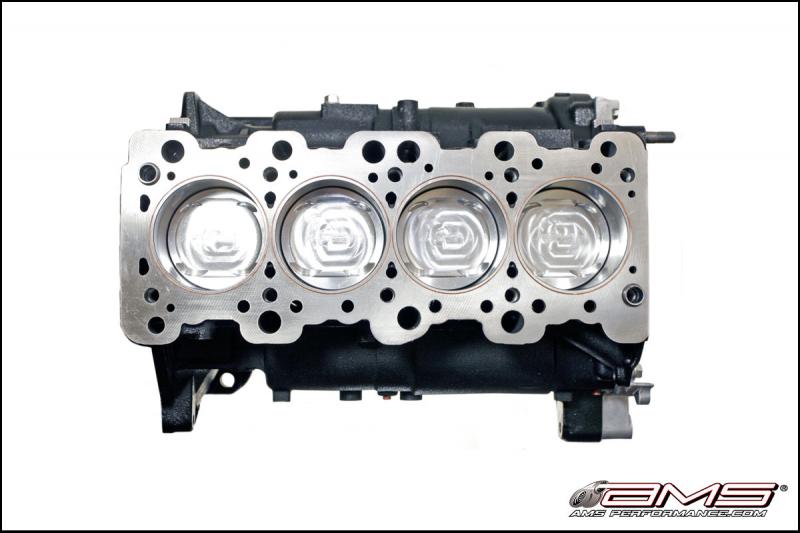
The second is the bellhousing casting. That will be explained below.
Wide Blocks vs. Narrow Blocks
There is a lot of confusion here for many people. The difference is 1 inch - thats it. A wide block measures one inch wider than a narrow block at the lower bellhousing bolts. Simple as that. If you don’t know which block is wide or narrow, measure it. If you have not memorized which blocks are wide or narrow, check the chart.
FWD vs. RWD
Again, more confusion. The differences are these:
- Wide or Narrow bellhousing casting
- Orientation bellhousing casting
The most important thing to remember is the Orientation. There are 3 orientations of Mitsu engines with many different variations:
- Rear Wheel Drive (RWD)
- These were BOTH wide and narrow. There are TWO deck castings (DSM and EVO) available in both wide/narrow bellhousing castings in the 4G6X family.
- Front Wheel Drive (FWD)
- These are ALL narrow. There are TWO deck castings (DSM and EVO), and TWO bellhousing castings in the 4G6X family.
In the FWD chassis, there are 2 orientations:
- Drivers side orientation (left side in the US)
- Passenger side orientation (right side in the US)
A General rule for mounting FWD narrow blocks to RWD chassis is:
“You CAN mount a Drivers side orientation 4G6X narrow block to a RWD transmission.”
“You can NOT mount a Passenger side orientation 4G6X narrow block to a RWD transmission without a mounting solution.”
What is a mounting solution and why do you need one?
Simple. FWD blocks with passenger side orientation have and axle located directly in line with the right side of the blocks lower trans mounting bolt. Mitsubishi’s solution was to move the lower mounting bolt hole up about 2 inches to clear the axle while maintaining the same amount of bolts to the transmission. The Drivers side oriented engines have their axles located on the left side of the engine where they do not interfere with mounting.
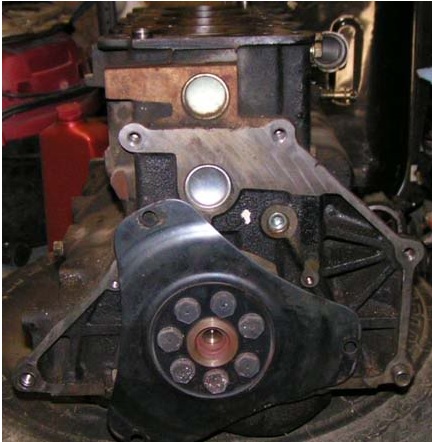
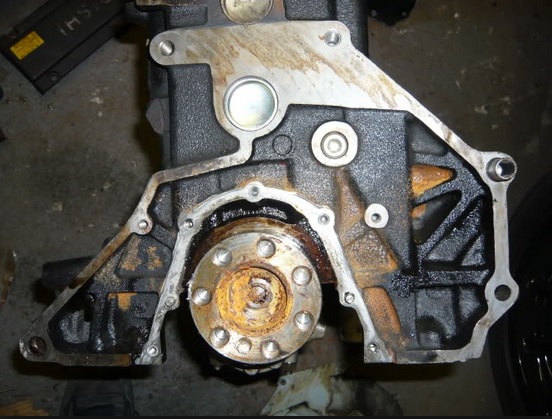
With that in mind, the general rule above applies. The FWD narrow bellhousing patterns differ by one bolt. When mated to a RWD narrow transmission, one bolt will have to be left out. This is NOT recommended because of the higher output potential and general weakness of the RWD transmissions in general. There are solutions to this problem, and we will get to them later - do not lose hope just yet. Keep reading.
Cylinder Heads
Cylinder heads carry a similar manufacturing variation as the blocks. There are obvious variations between single cam (SOHC), dual cam (DOHC), 8 valve, 16 valve, orientation, casting, etc. are all variations of the same 4G6X cylinder head family. This article is aimed at 16v DOHC specific cylinder heads of the 4G63 DSM and Evo variants.
DSM
DSM heads have a specific casting that matches the appropriate deck on the DSM block. The intake ports are the LEFT side of the engine while the exhaust ports are on the RIGHT. The bolt pattern for the head bolts are the same as any other 4G6X engine. There are 2 different intake port sizes to chose from (large or small port), and everyone likes to provide an opinion on which one is better.
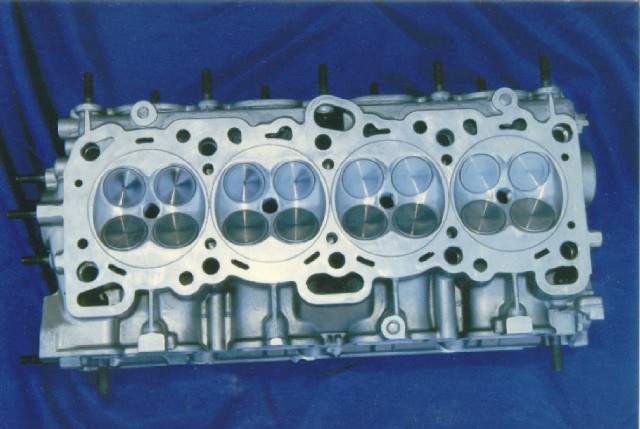
Evo
Evo heads have a specific casting that matches the appropriate deck on the Evo block as well. The casting is NOT the same as the Evo head and is NOT compatible. The reason why will be explained later. The Evo intake ports are on the RIGHT side of the engine while the exhaust ports are on the LEFT. This is opposite of the DSM. The head bolt pattern is also the same for the 4G6X family.
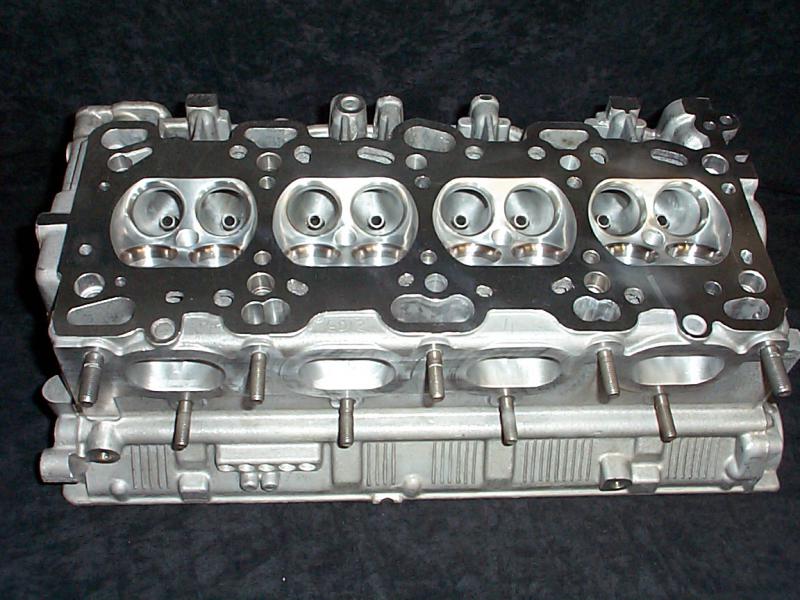
Hopefully you can see the differences between the two castings. Now we move to the fun stuff where we put all of this together!
Head and Block Interchange
This is perhaps the most confusing and often given the most incorrect information when asked about. I will explain each version and “why” each version can or can not be done. It is actually very easy if you can remember it.
DSM Cast Block with DSM Head
YES! All day and night - these blocks are completely compatible. This is why you can slap a DSM 4G63 DOHC head on to a RWD DSM casted 4G64 block without any block/deck mods. They are compatible because they are the same type of block.
There are different variations of the bellhousing casting which are wide or narrow casting. Generally speaking - a WIDE block 4G64 comes out of the RWD truck or van. A Narrow 4G64 comes out of a car with transverse drivers side orientation. A 4G63/G63B is in both cars and trucks, and are all narrow blocks.
Evo Cast Block with DSM Head
Yes. This has been done, and can be repeated a dozen times. Oil drain blocking is REQUIRED when adding a DSM head to the Evo block because the DSM block and head do not have as many drain holes as the Evo types. There are many write-ups regarding the swap and port mods to block the off the unused oil ports.
The most popular swap instance is the 4G64 Eclipse with a DSM head. The 4G64 Eclipse has a narrow block with a DSM casted bellhousing and an Evo casted deck. Since the DSM head is different, some mods need to be made to block off the oil drain ports.
DSM Cast Block with Evo Head
NO!! Simply put - there are not enough drain holes for the DSM block to properly drain the oil from the EVO head. When you switch to this combo, you end up with only 5 holes to drain oil instead of 10. The oil will go up to the head and may stay there for a long time. This may eventually lead to oil starvation and a blown engine.
It HAS been done before by a few people with some extra time and a “why not give it a go” type of attitude. However, many have had to make extensive mods, and others have failed to report back years later for a status update. This is NOT recommended.
Evo Cast Block with Evo Head
YES! All day and night - these blocks are completely compatible. There are actually MORE options with compatibility when using EVO casted engines.
Just remember - You can slap a DSM head on any 4G6X family block with mild mods. You can ONLY slap an Evo head to an Evo block.
More Specific Head Mentions
We left a few heads out of here such as the SOHC 16 valve valve heads, SOHC 8 valve heads, and a few other little mentions. This is mostly because there are not a lot of “powerhouse chasers” looking for compatible single cam heads. However, the SOHC 16 valve heads are Evo casted while the SOHC 8 valve heads are DSM casted. The primary difference is which side of the engine the ports are located. One example is using the 7G Galant or Eclipse Spider 4G64 blocks with the 8G Galant or 3G Eclipse 4G64 head. Both can be transplanted to the MM with a narrow block transmission, but the intake and exhaust ports would be opposite. The manifold casting is also slightly different on the 8G Galant or 3G Eclipse 4G64 head.
The Unicorns
There are a few blocks and heads that make RWD compatibility less of an issue. These are blocks and heads that have dissimilar castings to make mating them the perfect pieces to solve the puzzle.
There is ONE block in existence that will allow you to make a RWD 4g63 2.0L Evo possible WITHOUT any mating mods. It is the closest you will ever get to a factory RWD Evo platform. That block was available in the 1993 Galant. This engine was a 2.0 narrow block with a DSM bell housing, 7 bolt crank, and Evo cast deck. It doesn't get any closer than that.
As mentioned before, the 7G Galant and 2G Eclipse Spyder 4G64 blocks are narrow blocks with Evo deck castings, not DSM. That makes turning your Mighty Max into an Evo driven beast very possible with a narrow block transmission.
Another prime candidate for Evo consideration is the 97+ Montero Sport 4G64 block. This is the only WIDE block cast bellhousing with an Evo cast deck. This makes mating an Evo variant to a wide block transmission possible.
Wide or Narrow? The choice is yours. They are nearly the same. However, you do get a better choice of clutches and flywheels when you use a narrow block. You can also upgrade to a Hydraulic factory clutch provided that you source a factory Hydraulic clutch equipped transmission in either wide or narrow block form.
Using an Actual 4G63 Evo IV through IX
You have 2 options for this if you are determined to use an actual Evo 4G63 instead of a variant. One option is purchase a bellhousing adapter that mates the Evo cast bellhousing to a different transmission. It is offered by Bills Auto Fabrication http://www.billsautofab.com/recent_mit.asp.
Option two is to build one yourself and adapt it to whatever you would like.
This also applies to the FWD 8G Galant, 3G Eclipse, Outlander 4G64, 4G69, and the engines Chrysler/Dodge used made by Mitsubishi.
Speaking of transmission options….
Transmissions
Let’s make this really simple. There are basically 4 factory RWD transmission castings for you to chose from:
- Narrow DSM cast with cable clutch transmission
- Narrow DSM cast with Hydraulic clutch transmission
- Wide DSM cast with cable clutch transmission
- Wide DSM cast with Hydraulic clutch transmission
Those are the basic options for using a factory manual transmission. None of them are cast to match the Evo cast bellhousing found on the later FWD/AWD 4G6X narrow blocks. You need an adapter for a different transmission. There are many to chose from in many different combinations.
Accessories for Rear Wheel Drive Conversions
We’ve read many of the problems associated with swapping a FWD block into a RWD regarding the cooling. Why is this a difficult decision to make? Well, it usually has to do with being the decision to cut the firewall or hammer mod it.
How about the accessories? Do I use a 3 belt system? Perhaps a 2 belt system? Can I use a single serpentine belt from the Evo? How about AC and power steering….? Which ones do I use?
Good news! There are factory solutions and answers.
Engine Mounts
Montero Sport 2.4 engine mounts (the lower/rubber portion that bolts to the chassis) are identical to the MM.
The actual bracket that bolts to the block is different. The difference is great, though. Montero sport block mounts move the engine forward to provide clearance which eliminates the need to jackass the install with hammer mods or cutting. This is a bolt-on solution for the swappers. You no longer need to make custom mounts - just find the MS block mounts/plates and have a good day.
In addition, the tail shaft of the Montero Sport 5 speed sits about an inch rearward compared to the stock MM. This means the shifter will stay in the exact same place as stock if you use the MS tail shaft and shifter after moving the engine forward.
Here are the part numbers for the Montero Sport engine mount plates:

(Ref. #1) Right side mount - MD308249
(Ref. #2) Left side mount - MD322806
These are found on the '97-'99 Montero Sport 2.4 2wd. The rubber mou ts are exactly the same as the MM.
I can't find a breakdown or part number for the tail housing but that is also a part you might want to source. It will allow you to keep the shifter in the exact same location as your MM after moving everything forward. You could get away without using it, but this is an option for you. You will need to source the tail housing, shifter housing and shifter.
The driveshaft can either be lengthened - or - you can have a spacer machined that bolts on between the yoke flanges of the drive shaft and differential. It's up to you which one you want to go with.
Cooling system
What if you don’t want to play Whack a Mole with your firewall? What if you can’t justify slicing up perfectly good sheet metal just to shoehorn an engine in? Why do you have to worry about this to begin with? - because on the back of every FWD head you will find the thermostat housing or coolant port. This is usually located in the center of the engine bay of a FWD car.
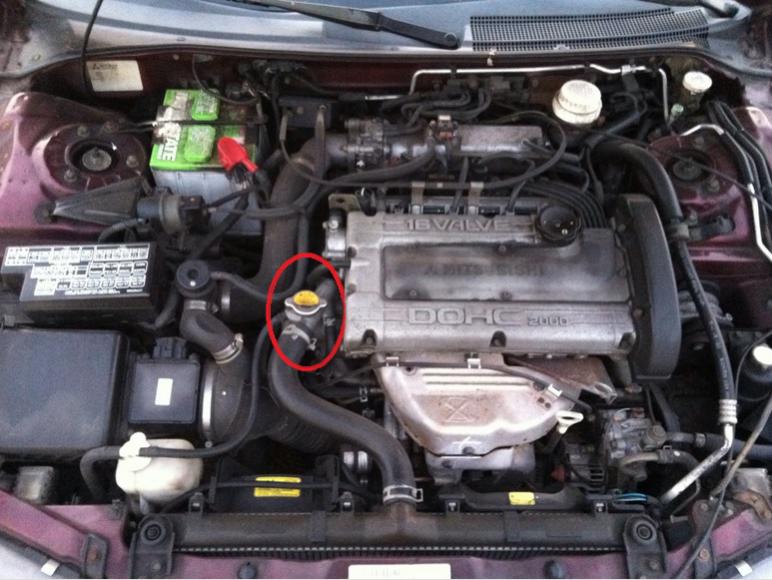
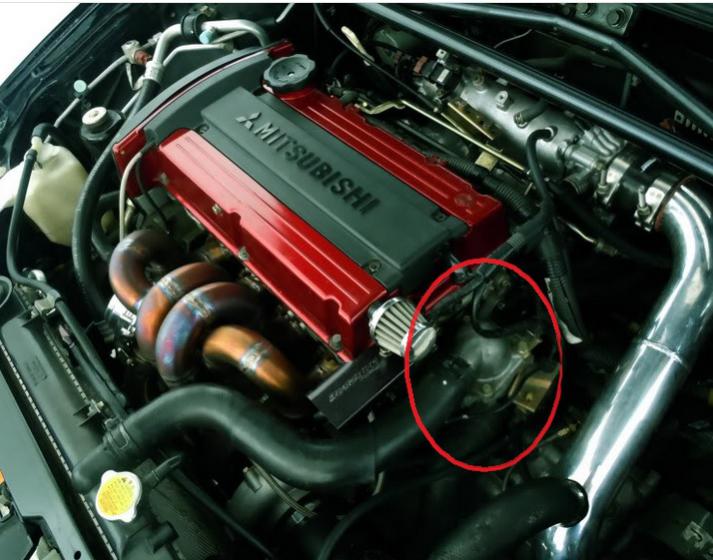
For future reference, those of you who want to use the Hyundai/Kia head for your Evo variant build, the neck is in the same location.
A solution exists from Mitsubishi. It is a solution they used to mount and does not require you to smash the hell out of your firewall or slice it up. The 97+ Montero Sport 4G64 engine uses a thermostat housing located on the right side of the block. This also has the return port for from the heater lines and back of the head for flow.
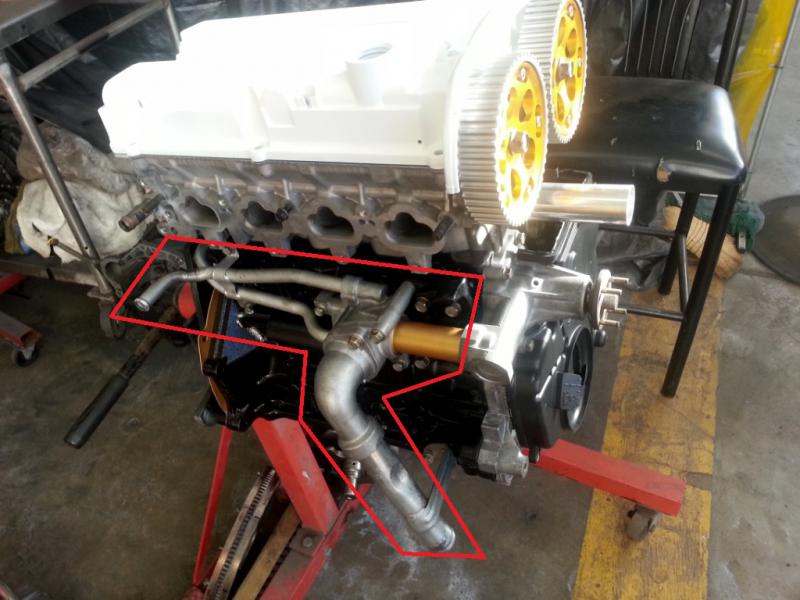
Utilizing the Montero Sport coolant housing does require a couple mods to pass coolant back to the radiator. For starters, you need to add a port to the front of the head. DSM, Evo, Hyundai and Kia have a freeze plug located on the front of the head. You can pop the plug out and attach a pipe or hose adapter which will lead straight to the upper radiator.
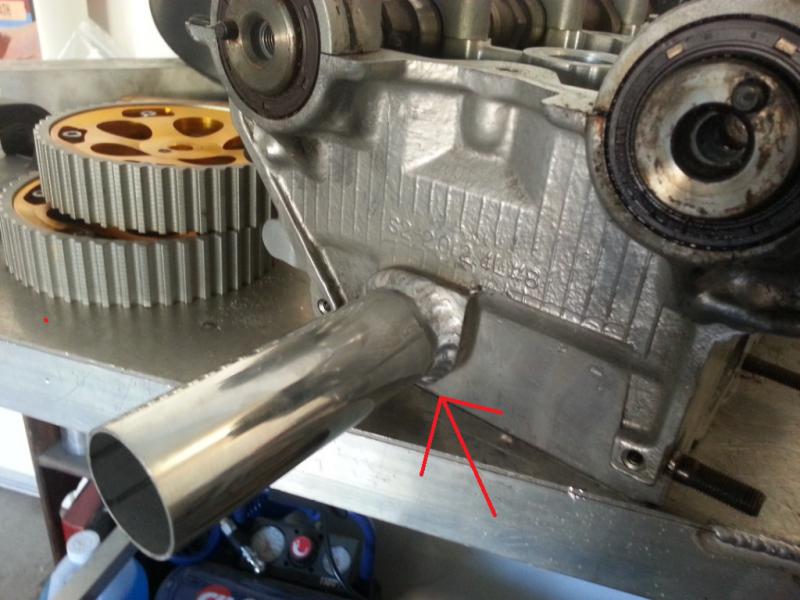
The back of the head needs a modification as well. The port for the factory thermostat housing needs to be blocked off, but a hose barb/nipple needs to be added to feed the heater and a flow port needs to be added.
The Evo, Hyundai and Kia heads have a coolant port already built into the right rear of the head. This port gets routed back to the Montero Sport thermostat housing via the water pipe on the assembly. You will need to either add a port to the block off plate to feed the heater, or tee the port off of the right rear port on the head.
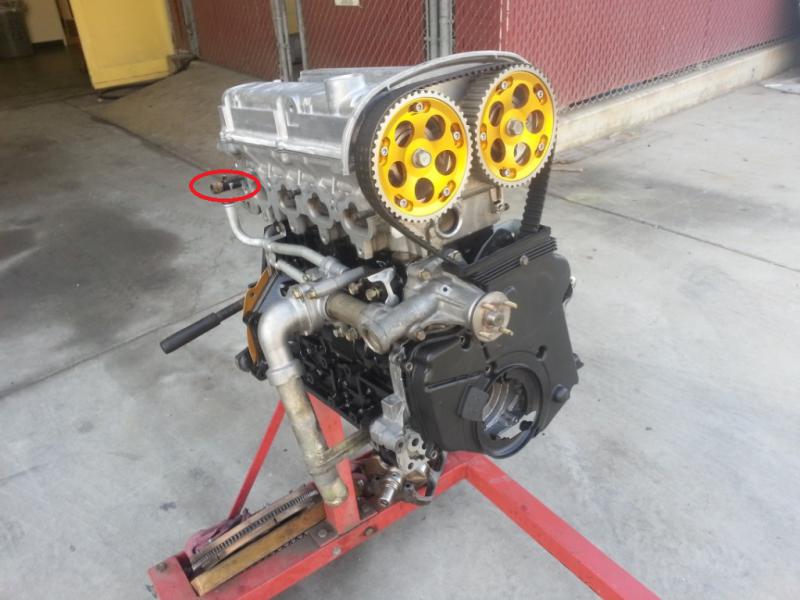
The DSM does NOT have this port built in. The solution is to tap a branch tee (or two separate fittings) into the block off plate. This will feed the heater and return coolant to the water pump.
These mods will eliminate the need to smash up the firewall. These mods will also delete the need to run a water pipe to the back of the engine.
Water Pumps
Believe it or not, there are quite a few variations of water pumps for the 4G6X family. The general rule of thumb is to use the water pump that matches the accessories you are using (alternator, power steering, AC, etc.).
If you chose to use the Montero Sport thermostat housing, you may need to fabricate a custom water pipe depending on which water pump you use. The reason why is the clocking of the water pump might change the position thus moving the water pump inlet higher, lower, or offset (closer/farther from the block).
The Evo water pump is the oddball. For starters, it rotated in the opposite direction of the other 4G6X water pumps (except 4G69). It is also clocked much higher with an inward offset. It is completely possible to use it with the Montero Sport thermostat housing if you fabricate a water pipe to adapt it.
Again, the simplest solution is to use the matching water pump to the accessories from each specific engine you are running.
Oil Pumps
This is another interesting find. The oil pumps have differences throughout the family. The same rule of thumb also applies - use the matching oil pump to the accessories.
Alternator, Power Steering, Air Conditioning
There are a few combinations here as well. Again - match them to the other accessories from each series you intend you use. It would take another dozen pages to list each one, so keep the rule of thumb in mind.
Yes, there are solutions to deleting unneeded accessories (like AC/PS). This is not limited to any engine. You can use or delete whichever accessories you don’t need accordingly. The only tough solution would be the water pump pipe to the Montero Sport thermostat housing if you intend to use it. Also keep in mind that if you run the Montero Sport accessories, you will have 3 belts to deal with instead of 2 or less. The brackets are also different. This can be challenging for some to adapt.
The Fan
The fan bolt pattern is the same throughout. The only issue you may encounter (if you chose to use the mechanical fan)is the difference in snout lengths of the different water pumps. Mitsubishi used different snout lengths and pulley offsets throughout the 4G6x family. While it may be possible to mount the mechanical fan to any 4G6X water pump, it may interfere with other components. Replacing the mechanical fan with a quality electric fan is highly recommended.
Cam Position Sensor Vs. Heater Core
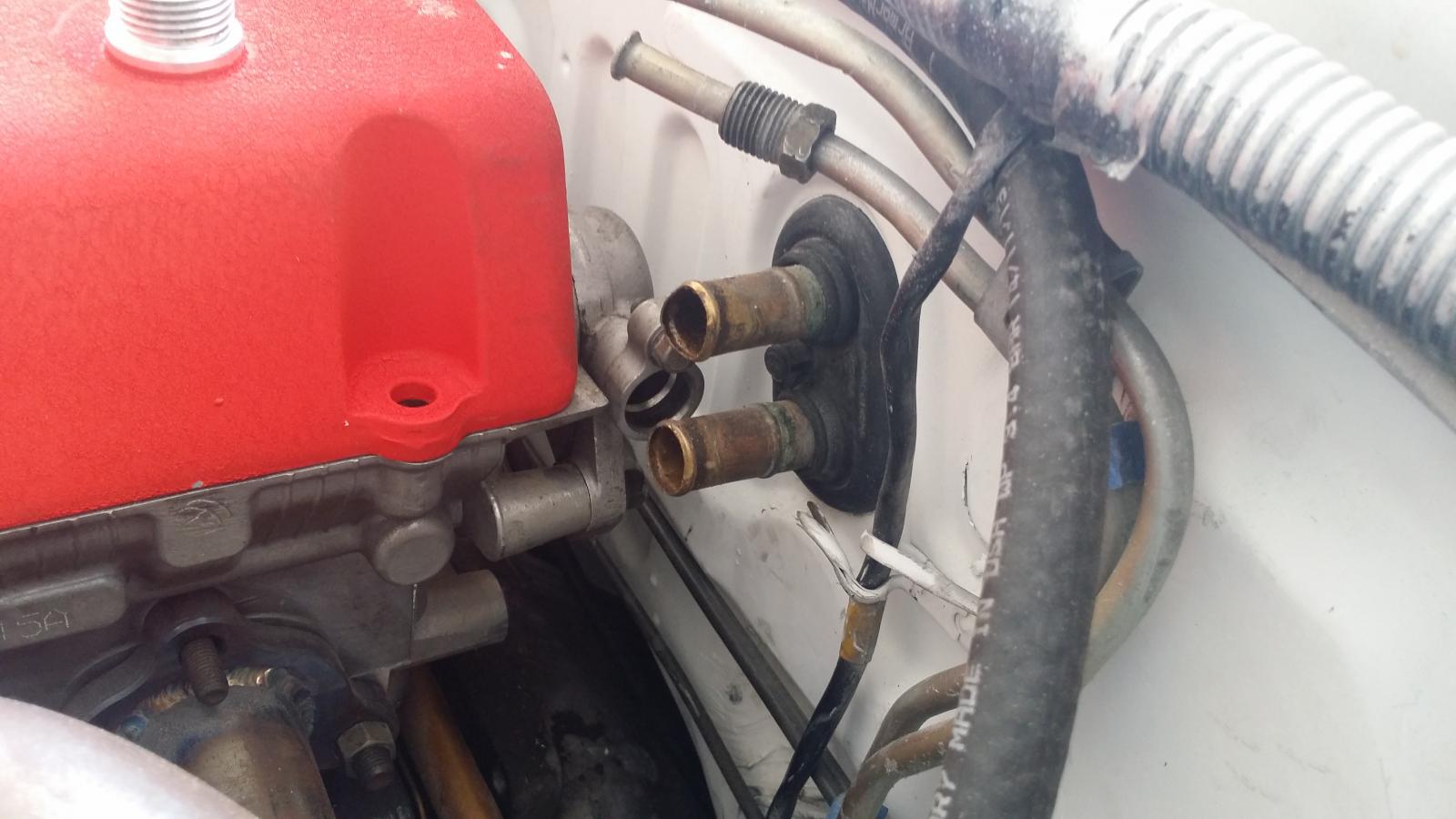
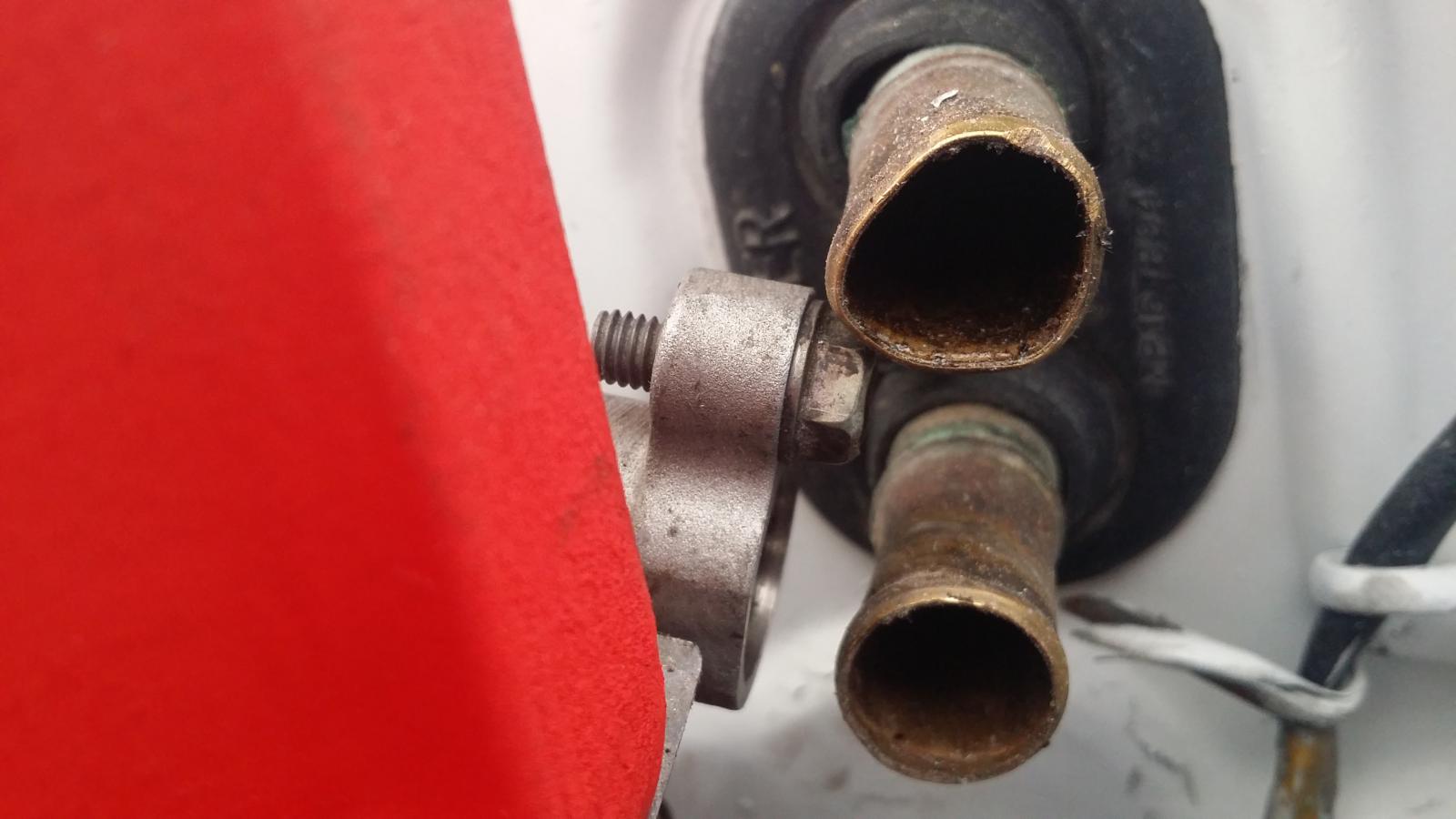
The cam sensor directly interferes with the heater core tubes. This can be solved by phasing the sensor and reluctor, or finding another routing solution... I'll figure it out later and provide the solution.
Master Cylinder
This really only applies to the RHD community. Mitsubishi makes 2 versions of many master cylinders - Ones with ports on the right, and ones with ports on the left. I do have a giant custom intake manifold (as pictured up top), but either way, find a master cylinder with its ports located on the right side. It makes for a much tidier installation and will not create an interference problem.
For the LHD community, use the LHD port master cylinder. This will give more space for your header.
Finally, The ECU
There are tons of options. It is up to you which ECU you want to run to power your engine. It is no secret that a DSM ECU can run an Evo engine. An Evo ECU can run a DSM engine. The Mighty Max 4G64 ECU is nothing more than a dumbed down DSM ECU. The 3G 4G64 Eclipse ECU is a dumbed down Evo ECU. The Mirage 4G9X series ECU’s are very similar to Evo ECU (and can be flashed/run on Evo ROM’s). The options are endless.
The wiring needs to match the ECU. This can be tricky for some that are not strong with electrical work. Just remember there is a harness and ECU for just about anything you want to swap. As such, there is probably a solution or adapter on the market for it.
Conclusion
There is a lot of reading here. If you feel something has been missed, feel free to PM me or reply here. If you have a specific question, please PM me or post here.
The Evo variant is not that difficult to put together. The information is here - all you have to do is make a decision and pull the trigger on the build.
Good luck!
Charts
Below is a quick reference charts for your personal use. It will help you quickly decide which combination you would like to build in whichever fashion.
Please ask permission to re-post this somewhere else, and please credit me for the information. I would like to track where and how the information is going as best as possible to provide possible updates and correct the information for new discoveries.
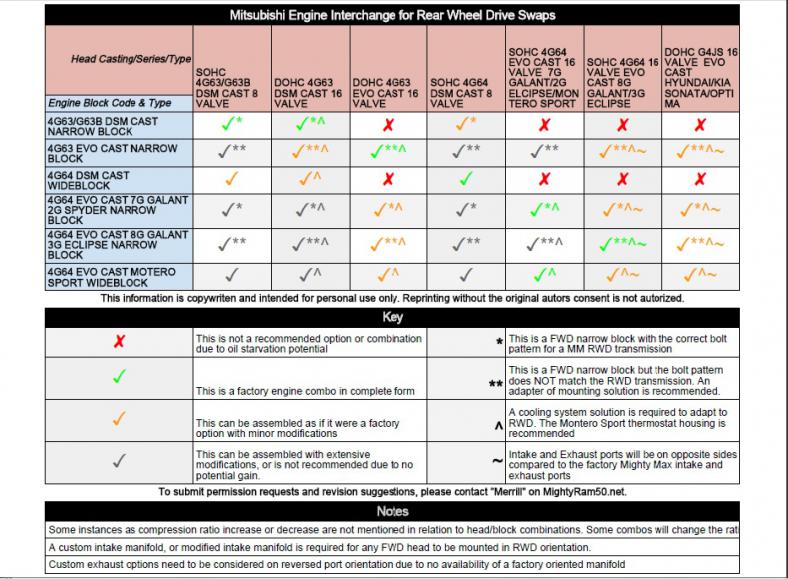








 Reply With Quote
Reply With Quote










Bookmarks